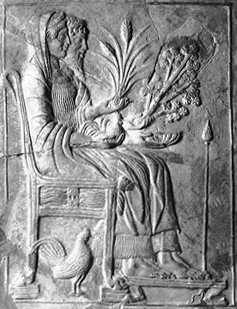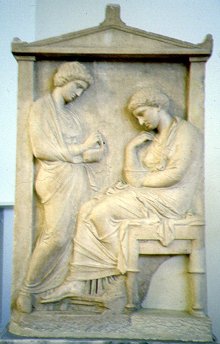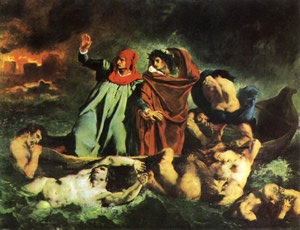Featured
Deity
AIDHS
(Hades,
King of the Dead) |
How
to identify him: It's tough. He's invisible! But if you meet him, you'll know
it. |
Roman Name: Pluto
Spouse: Persephone (Roman: Proserpina)
Sacred City: None--he doesn't get out much
Sacred Plant: Asphodel
Totem Animal: Either pure black or barren (infertile) sacrificial animals, usually sheep or cattle.
The background of the table above is
a field of asphodel flowers.
 The name "Hades" means "invisible" or "unseen," which is a pretty good description
of Hades' place in the mythological record. Except for the story of his marriage,
he doesn't have an active role in any myths because usually he's too busy to leave his
kingdom. The only story that centers around him as an active participant was the occasion on
which he claimed his bride, Persephone, who is his partner in everything. Even in sculptures and
paintings you almost never see him without Persephone at his side, as in the bas relief sculpture
to the left.
The name "Hades" means "invisible" or "unseen," which is a pretty good description
of Hades' place in the mythological record. Except for the story of his marriage,
he doesn't have an active role in any myths because usually he's too busy to leave his
kingdom. The only story that centers around him as an active participant was the occasion on
which he claimed his bride, Persephone, who is his partner in everything. Even in sculptures and
paintings you almost never see him without Persephone at his side, as in the bas relief sculpture
to the left.
Notice the rooster underneath Persephone's throne. This was a common
sacrifice to the gods of the underworld or to the gods of healing. The connection
between medicine and death was very close in the ancient
world, as indicated by the two separate vials of blood from a slain monster, the Gorgon Medusa,
that Athene presented to Apollo's son Asclepius. The blood from one side was poisonous, and
the blood from the other side could be used to heal. For an interesting modern application of
this story, check out this excerpt from Bill Hayes' "Personal and Natural History of Blood," Five Quarts.
You have to move through a few paragraphs and scroll down the page a bit before you get to the bit about Asclepius.
This close connection between death and healing might be why the famous philosopher
Socrates' very last words after he drank his potion of the poison hemlock were
to remind his friend Crito to offer up to Asclepius the rooster that would no
longer be needed to awaken him in the morning: "Crito, we owe Asclepius a cock,
pay it and do not neglect it." It's almost as if he found death a welcome end
to a painful disease--in his case, not a physical disease but the mental anguish
of watching his beloved Athens fall into chaotic decline in the wake of the disastrous
Peloponnesian War. The Greek word for medicine or drug, pharmakos, was
also the word for poison.
Hades' wife is far more active than he. Even in Homer's Odyssey, when the hero
Odysseus descends to the underworld and has some unpleasant experiences there,
he claims repeatedly that it's Persephone, not Hades, who is tormenting
him. Hades himself is just a little too scary to be mentioned out loud (note that Jim Henson
picked up on this in Hades' creepy speech in the Orpheus video shown in class on September 9).
Therefore a number of euphemisms have sprung up around his name, such as
Polydegmôn ("receiver of many") and Polyxenos ("host to many," as he is
repeatedly called in the Homeric Hymn to Demeter). Sometimes Hades was called Zeus
Katachthonius, or "the underground Zeus."
Hades misunderstood
It might be easier to understand Hades' role if you think of him in terms of that last-mentioned
title. Just as Zeus is the keeper of order among
the living, Hades is the keeper of order among the dead. He is not death itself--the
Greeks had a separate god for that, named Thanatos--but rather the ruler
over departed souls. As Helios pointed out to Demeter in the Persephone video, this
makes him in a way the most powerful king possible--perhaps more so even than
Zeus--since the dead outnumber the living and thus Hades has far more subjects than his brother.
He is extremely fair and just, so much so that he is unbending,
unforgiving, and utterly inflexible. He's not an evil individual by any means,
but he's sort of like that irritating person at work who always quotes from the
rule book and refuses to deviate an inch from standard procedure. You know they're
right, at least technically, but that doesn't make it easier to accept.
Here's another common misunderstanding:
in fact, Hades' realm does not have exactly the same name as its ruler in the
original Greek, though it's frequently translated that way. Greek is an inflected
language, which means a word takes on different endings to indicate its grammatical
function. When his name is used to refer to the underworld, it is invariably used
in the possessive--Hades' or of Hades. So the phrase Go to Hades'
would have the same grammatical structure as Eat at Joe's. The underworld
is named after its ruler in the same way that Joe's is named after its owner.
You don't call the restaurant Joe, and an ancient Greek didn't call the underworld
Hades.
Contrary to what Chapter 9 in our textbook might seem to imply, the Lord of the Underworld
wasn't all bad or scary. As Pluton, Hades is the god of wealth--and
indeed, the materialistic Romans took "Pluto" as his given name. This is because
of his underground home, the source of mineral wealth in the form of gold and
gems and agricultural wealth in the form of crops (which explains his relationship
with Persephone).

You can't take it with you... but the living can't keep it, either
Valuable weapons and jewelry were frequently buried with a corpse in order
to keep its ghost at rest and prove the survivors were not receiving too much
benefit from a relative's death. It was also common for wealthy women's grave
markers, like the one on the right, to portray the deceased's jewelry box. The
box is usually held by a slave as the mistress chooses her favorite ornament.
Men who died in battle were usually portrayed in full armor, with their weapons
at rest beside them. Virtually everyone, including the poor, would be buried with
pottery items--which, as you might imagine, is a real boon for archaeologists.
This is not an indicator of the belief that "you can take it with you."
It's quite the opposite. There is a significant difference between the gloomy
classical idea of the afterlife and that of their more optimistic neighbors, the
Egyptians, who enjoyed their
time on earth so much they couldn't conceive of an eternity that wouldn't be similar
to their everyday lives. Egyptian tombs were packed full of grave goods because
they believed that their dearly departed might need them in the next world.
Greek and Roman tombs were packed with the same to keep a jealous ghost from haunting
the survivors.
For the same reason, noisy and extravagant mourning was
considered appropriate. If you were worried that your own family wouldn't be able
to put on a noisy enough show, you could always hire professional mourners who
were guaranteed to scare off any errant ghosts who hadn't yet found their way
to their final destination. Given the pessimistic view of the afterlife that prevailed in
the classical world, it's no surprise that they weren't in a particular hurry to get there.
Hungry ghosts
Ghosts were also supposed to roam the earth on
moonless nights, which is why Hades is closely associated with the goddess
Hecatê.
You may recall that according to the Homeric Hymn to Demeter it was she who told Demeter
she had overheard Persephone's abduction, as opposed to the nymph Arethusa in
Ovid's Roman version or Helios in the British video version we looked at.
Hecatê was a goddess of boundaries and crossroads and the dark of the moon;
the Romans associated her with the more terrifying side of wild, untameable Diana
(the Roman version of Apollo's twin sister, Artemis).
 |
Lemur from Madagascar
The Romans also had a name for ghosts, lemures. I know that sounds funny
today--we can't help thinking of those odd little creatures from Madagascar--but the
Roman name came first. The animals were given the name by classically-educated
explorers because of their nocturnal habits, eerie silence, and bug-eyed appearance...
not to mention the fact that the local folk tradition claimed that they housed the souls of
the dead.
One way of keeping a ghost from walking was to pin its feet together, as was sometimes
done with abandoned infants. Oedipus, the hero of Sophocles' play Oedipus the King,
suffered this fate as a baby and was maimed for life as a result. The name "Oedipus" is a pun
that reflects on Oedipus's nature ("know-it-all") and on his physical characteristics ("twisted foot").
The topography of Hades' realm
Accounts vary about where Hades' kingdom is located.
In some cases it's under the earth, and in others, such as in the Odyssey,
it's at the western edge of the world, in the land of the Cimmerians. The Cimmerians
were a real people who lived near the Black Sea--north of Medea's home in Colchis.
If you don't know who Medea is, you will by the time you're done with this class.
It's not Medea herself, but her aunt, the witch Circe, who gives Odysseus directions
on how to get to the underworld. Both Medea and Circe are described repeatedly
in mythology as devotees of Hecatê, sort of in the same way that aggressive,
independent women were often branded as witches in colonial America. For more
information on this subject, listen to Vandiver's Lecture 21.
Archaeological evidence seems to point to a possible connection
between the entrance used by Odysseus and a subterranean temple complex perched
above the Acheron River in northwestern Greece. Yes, the Acheron is a real river. It's the
one that is usually seen as the outside boundary of the underworld. Its name means
"sorrowful." The other three rivers associated with Hades' kingdom, the Styx ("hateful"),
Pyriphlegathon ("flaming with fire"), and Lethe (river of forgetfulness, from which our word
"lethal" is derived), are wholly mythical.
Perhaps one of the reasons the Styx is so hateful is that awkward fact that it's the
river the gods swear by when they need to make a particularly binding oath. Once they've
sworn by the Styx, they cannot go back on their word or even use their typical trick of trying to
weasel around it. Unlike the unswerving Hades, most of the Greek gods are not
scrupulously fair and just: quite the opposite, in fact... which perhaps makes them seem more
human and less creepy!
Traditionally, spirits drink from Lethe on their way to the underworld so they will be able to bear
the loss of their life above ground, as we saw when the Styx's ferryman, Charon, offered the drink
to Eurydice in Jim Henson's Orpheus video. Plato changes this a bit in the "Myth of Er" in his
Republic (see page 300 of H&P's Classical Mythology and Vandiver's lecture 8),
where he introduces the idea of reincarnation and claims that the souls drink to forget their
previous life and begin afresh. Homer, writing some four centuries before Plato, doesn't mention
Lethe at all. As our textbook and lecture both emphasize, Homer's view of the afterlife is extremely
pessimistic. His gloomy ghosts have to continue in their shadowy existence with full knowledge of
what they have lost.
Acheron is not the only boundary. Sometimes Lake Avernus, near Naples, is described as a
portal to the underworld. This Italian alternative, of course, is the route that the Roman hero Aeneas
takes on his journey to Hades' kingdom. Other accounts say that there is an entrance to the
underworld through a bottomless lake at Lerna on the Peloponnese, and that that's how Dionysus, or
Bacchus, retrieved his human mother from the land of the dead. According to the 2nd-century traveler
Pausanias's description of Lerna
2.36.7,
"they say that Pluto, after carrying off, according to the story, Core, the daughter of Demeter,
descended here to his fabled kingdom underground." (Note: you will have to scroll nearly all
the way down the page or search with "Control F" to get to Lerna, but once you get there you'll
find a reference to a large statue of Demeter and a mention of the giant water-snake, the hydra,
slain by Heracles--the Greek name for Hercules--on the marsh of Lerna as one of his famous
Twelve Labors.)
 Sometimes the ancient writers mention a place called Erebus, which is either
the final destination of the dead or a place that they pass through. If it's their
final destination, Tartarus is depicted as a separate area, circled by the flaming river
Pyriphlegathon, where punishment is doled out to those who offended the gods. If Erebus is
just a place they pass through, everybody winds up in Tartarus but it's divided up into better and
less desirable neighborhoods.
Sometimes the ancient writers mention a place called Erebus, which is either
the final destination of the dead or a place that they pass through. If it's their
final destination, Tartarus is depicted as a separate area, circled by the flaming river
Pyriphlegathon, where punishment is doled out to those who offended the gods. If Erebus is
just a place they pass through, everybody winds up in Tartarus but it's divided up into better and
less desirable neighborhoods.
The meadows of asphodel are located either in Erebus or in Tartarus--wherever
the spirits wind up. Despite the rather pleasant name, don't confuse the asphodel
meadows with the Elysian fields. Asphodel is a ghostly-looking flowering weed (see
the photo to the right). The fields of Elysium are a riotous
paradise of every pleasant, colorful plant you can think of. The only problem is, nobody
knows exactly where these fields are.
Where are those blessed fields?
Some authors locate the Elysian fields somewhere out in the sea, on the "Islands
of the Blessed," which means we might conceivably be able to get there!
In the second century C.E., about the same time
Pausanias was writing his Description of Greece, the satirist Lucian imagined
just such a possibility in his True
History. A boatload of sailors who have been blown off-course wind up on these
islands after a number of other improbable adventures, including the Jonah-like
experience of being swallowed by a whale, which is where the page I've linked
to picks up. On the islands, the crew meets up with the deceased Homeric heroes--as
well as with Homer himself, who is busy competing (and losing!!) against Hesiod
in the all-Elysian athletic games. The ever-wandering Odysseus is bored out of
his skull and wishing he could go off on another voyage, so he smuggles out a
message to his ex-lover, the immortal sea-nymph Calypso, with the help of the
story's narrator. The late King Menelaus of Sparta runs up against a familiar
situation when his wife, Helen of Troy, runs away from him (again!) with one of
the sailors. Later the hero of the story sees the errant sailor being tortured
in Tarturus, and Helen is returned (again!) to Menelaus, so I guess you could
say it turns out okay. Except for the sailor, of course.
The Victorian poet Alfred, Lord Tennyson, had a more serious take on the same
idea in his poem "Ulysses," which you can find in the back of your textbook in the
chapter on "The Persistence of Myth." The aging Ulysses--the Roman name
for Odysseus--has grown restless and wants to take one last voyage,
...for
my purpose holds
To sail beyond the sunset, and the baths
Of all the western
stars, until I die.
It may be that the gulfs shall wash us down;
It may
be we shall touch the Happy Isles,
And see the great Achilles, whom we knew.
 |
Dante and Virgil in trouble
(Eugene Delacroix, 1822)
Those
spirits who are not bound for Elysium or the Islands of the Blessed have
to cross a river (either Acheron or Styx) in the boat of the ferryman Charon.
According to some
sources, the Styx was a river goddess, and she was in fact Charon's mother as well as his
workplace. One mythographer, the so-called "Pseudo-Apollodorus," claimed that Styx was
also the mother of Persephone ( ! ! ).
To pay the ferryman, a person would be buried with coins under his or her tongue.
Without that fare, the spirit would suffer the same fate as those who were improperly
buried and would be required to wander aimlessly on the far bank of the river
for a hundred years. The idea of the wandering of improperly buried souls is very
important to keep in mind if you are to fully understand the significance of Sophocles'
famous tragedy Antigone, where the young princess of Thebes, Oedipus's
daughter, risks (and ultimately sacrifices) her life for the sake of burying her brother.
According to some sources, Charon's boat is made out of horses' hooves, the only
material that can resist destruction in the corrosive waters of the Styx. Horses' hooves
are a very light substance, but then an insubstantial spirit doesn't weigh much.
In Virgil's Aeneid, the human bodies of Aeneas and his guide nearly sink
the boat, and the same thing almost happens again in Dante's Inferno when
Dante and Virgil climb on board.
The planet Pluto's solitary moon is named Charon. Even though this satellite wasn't
discovered until 1978, and Pluto has now been demoted to the status of "dwarf planet"
(mythologically enough, the asteroid Ceres was promoted to the same status at the same time, which gave
Pluto's mother-in-law equal status at last), the tradition of giving mythological names
to newly discovered orbiting objects continues. Luckily it seems like most of the new moons
are discovered around Jupiter, which makes it easier on those doing the naming--seems
like no matter how many of them accumulate, there's always one more lover who hasn't
been honored with a moon yet!
The most thorough description of Hades' realm is given
by Virgil, which is not really surprising. The Aeneid, like Apollonius's
Argonautica, is primarily a literary epic that was written by the author
rather than an old-fashioned oral epic composed on the fly, like Homer's works.
Because of this distinction, such poems tend to be a little more elaborate.
To get a sense of the physical layout of Hades' realm, check out Carlos Parada's map of the underworld, which charts the progress of both Odysseus
and Aeneas. Don't miss the text below the map, which is very useful. Parada also offers an
exhaustive annotated and illustrated
rundown on the underworld and afterlife. If that doesn't answer any lingering
questions you might have, I'd be really surprised!
Return to the top of this page
 The name "Hades" means "invisible" or "unseen," which is a pretty good description
of Hades' place in the mythological record. Except for the story of his marriage,
he doesn't have an active role in any myths because usually he's too busy to leave his
kingdom. The only story that centers around him as an active participant was the occasion on
which he claimed his bride, Persephone, who is his partner in everything. Even in sculptures and
paintings you almost never see him without Persephone at his side, as in the bas relief sculpture
to the left.
The name "Hades" means "invisible" or "unseen," which is a pretty good description
of Hades' place in the mythological record. Except for the story of his marriage,
he doesn't have an active role in any myths because usually he's too busy to leave his
kingdom. The only story that centers around him as an active participant was the occasion on
which he claimed his bride, Persephone, who is his partner in everything. Even in sculptures and
paintings you almost never see him without Persephone at his side, as in the bas relief sculpture
to the left.

 Sometimes the ancient writers mention a place called Erebus, which is either
the final destination of the dead or a place that they pass through. If it's their
final destination, Tartarus is depicted as a separate area, circled by the flaming river
Pyriphlegathon, where punishment is doled out to those who offended the gods. If Erebus is
just a place they pass through, everybody winds up in Tartarus but it's divided up into better and
less desirable neighborhoods.
Sometimes the ancient writers mention a place called Erebus, which is either
the final destination of the dead or a place that they pass through. If it's their
final destination, Tartarus is depicted as a separate area, circled by the flaming river
Pyriphlegathon, where punishment is doled out to those who offended the gods. If Erebus is
just a place they pass through, everybody winds up in Tartarus but it's divided up into better and
less desirable neighborhoods.
